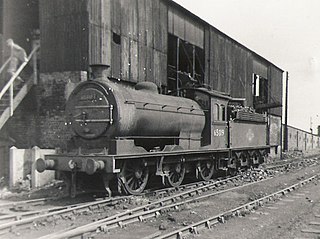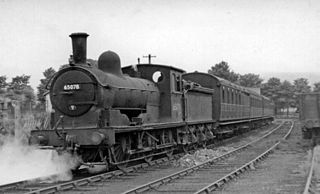
The North Eastern Railway (NER) Class P3, classified J27 by the LNER, is a class of 0-6-0 steam locomotive. The P3 Class was designed by Wilson Worsdell and was a relatively minor modification of the existing North Eastern Railway NER Class P2. The most significant change was a deeper firebox with shallower sloping fire grate. This was achieved by raising the boiler slightly, and by reducing the clearance between the firebox and the rear axle. The P3 Class were a freight engine by nature and used for hauling long trains of freight.

The North Eastern Railway (NER) Class C1, was a class of 0-6-0 freight locomotives designed by T.W. Worsdell. They were used throughout the NER system, although particularly in Teesside between 1886 and 1962.

The North Eastern Railway Class S3, classified B16 by the LNER, was a class of 4-6-0 steam locomotive designed for mixed traffic work. It was designed by Vincent Raven and introduced in 1920. The earlier members of this class were fitted with Westinghouse Brakes - all of this equipment was removed during the 1930s.

The North Eastern Railway Class E1, classified as Class J72 by the London and North Eastern Railway (LNER) is a class of small 0-6-0T steam locomotives designed by Wilson Worsdell for shunting. They had inside cylinders and Stephenson valve gear.

The North Eastern Railway (NER) Class E, classified as Class J71 by the London and North Eastern Railway (LNER), was a class of small 0-6-0T steam locomotive designed by T.W. Worsdell. They had inside cylinders and Stephenson valve gear and were the basis for the later NER Class E1.

The North Eastern Railway Class M1 is a class of 4-4-0 steam locomotive, designed by Wilson Worsdell. 20 initial engines were built, then 30 further units were built, designated Class Q.
The North Eastern Railway (NER) Bogie Tank Passenger (BTP) locomotives were designed by Edward Fletcher in 1873. The locomotives were for hauling passenger services on branch lines. They had an 0-4-4 wheel layout and a total of 124 locomotives were built. They were designated G6 by the London and North Eastern Railway (LNER).
The North Eastern Railway (NER) Class K classified as Class Y8 by the London and North Eastern Railway (LNER) is a class of 0-4-0T steam locomotives designed for shunting. It was designed by Thomas W. Worsdell and five of these tiny engines were built in 1890. These were numbered 559-63.
The NER Class 3CC was a 4-4-0 steam locomotive designed by Wilson Worsdell for the North Eastern Railway and built in 1893. Only one was built and it was a compound expansion version of the simple expansion NER Class M1. The 3CC was originally classified M but was re-classified 3CC in 1914, at the same time as the M1 was re-classified M.

The North Eastern Railway Class S was a 4-6-0 type of steam locomotive designed for express passenger workings. The first example was built in 1899. They were very similar to the NER Class S1, except for the smaller wheels of the Class S.
The NER Class P was a class of 0-6-0 steam locomotives of the North Eastern Railway. They were designed by Wilson Worsdell for mineral traffic.
The NER Class L was a class of 0-6-0T steam locomotives of the North Eastern Railway. They were a specialised design, intended for use on the Redheugh and Quayside banks on either side of the River Tyne. They were replaced on the Quayside branch by NER Class ES1 electric locomotives in 1905 but were re-allocated to other duties.
The NER 38 Class was a class of 4-4-0 steam locomotives designed by Alexander McDonnell for the North Eastern Railway. Twenty-eight were built in 1884–5, and remained in service until 1915–23.

The GER Class M15 was a class of 160 2-4-2T steam locomotives designed by Thomas William Worsdell and built for the Great Eastern Railway between 1884 and 1909. The original (F4) class of locomotives were fitted with Joy valve gear which was notoriously difficult to 'set'. This earned them the nickname of 'Gobblers' thanks to their high coal consumption rates. As a result, between 1911 and 1920, 32 of them were rebuilt by James Holden with Stephenson valve gear and higher pressure boilers. Despite this, the nickname stuck for many years after.
The NER Class A was a class of 2-4-2 tank locomotives designed by Thomas William Worsdell and built at Gateshead works for the North Eastern Railway (NER). Sixty locomotives were built between 1886 and 1892. At this time the class was designated class A by the NER and was the first class in the company to be given an alphabetical letter classification.

The NER B and B1 Classes were two classes of 0-6-2 tank locomotives designed by Thomas William Worsdell for heavy freight and mineral on the North Eastern Railway, introduced in 1886. They were tank engine versions of the NER C1 Class 0-6-0, using both simple expansion and also the von Borries configuration for two-cylinder compound locomotives. Both types were later rebuilt using saturated steam and the compounds were also rebuilt as simple expansion locomotives, and eventually formed a single class. Many of the superheated locomotives were also later returned to saturated steam as their original boilers wore out. As a result the classes have had a very complex history mechanical history.
The NER Class S1 was a class of 4-6-0 steam locomotives of the North Eastern Railway. It was designed by Wilson Worsdell and five locomotives were built between 1900 and 1901 at Gateshead works. The S1 was similar to the NER Class S but had larger driving wheels and a higher boiler pressure.

The NER Class R1 was a class of 4-4-0 steam locomotives of the North Eastern Railway. The class was designed by Wilson Worsdell and built from 1908 to 1909.
The NER Class F was a class of 4-4-0 steam locomotives of the North Eastern Railway. It was designed by Thomas William Worsdell and introduced in 1887.
The NER Class V was a class of twenty steam locomotives of the 4-4-2 wheel arrangement. They were designed by Wilson Worsdell for the North Eastern Railway (NER) as express passenger locomotives.









